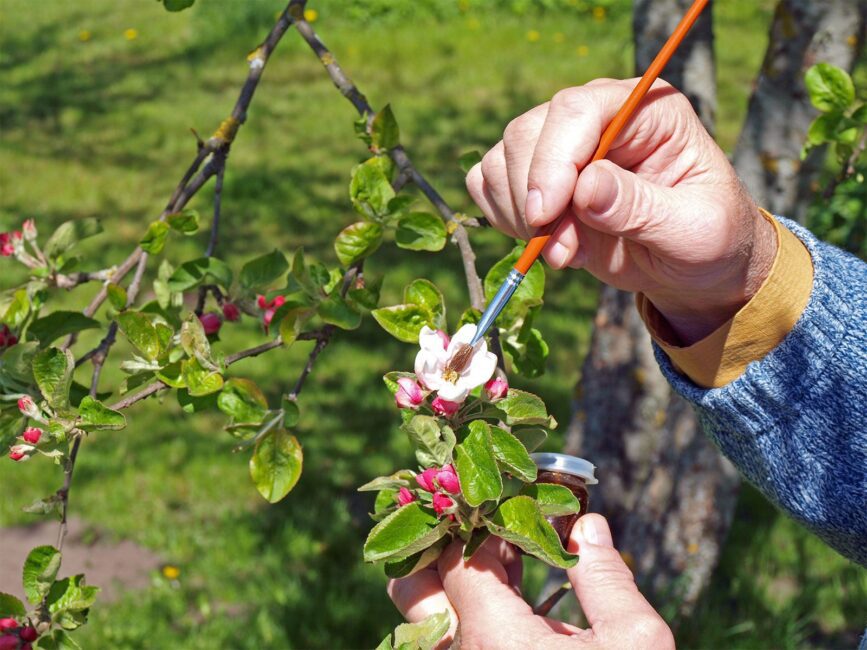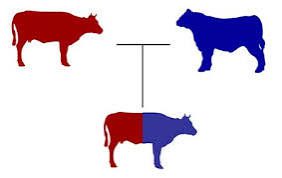Cross breeding is a fundamental practice in both plant and animal husbandry, aimed at enhancing specific traits and improving overall genetic diversity within species. This process involves the intentional mating of two distinct individuals from the same species or closely related species to produce offspring with desirable characteristics.
It is a vital tool in agriculture and livestock production, providing numerous benefits such as increased yield, improved disease resistance, and enhanced adaptability to environmental conditions.
In plants, cross breeding is often utilized to combine the best traits of two parent plants to create hybrids that exhibit superior qualities. This technique has been employed for centuries, with historical evidence tracing back to ancient civilizations that selectively bred crops for desirable traits like size, taste, and hardiness.
Modern agriculture has significantly advanced the methodologies involved in plant breeding, allowing for more systematic and controlled approaches to cross breeding. These methods may include controlled pollination, where pollen from one plant is deliberately transferred to the stigma of another, ensuring that the resulting seeds carry genetic material from both parents.
One of the primary motivations for cross breeding in plants is to enhance yield. By combining varieties known for their high productivity, breeders can develop hybrids that outperform their parents in terms of fruit or grain production.
This practice has become increasingly important in meeting the global demand for food, particularly as populations continue to grow and arable land becomes scarcer. Additionally, hybrid plants often display what is known as hybrid vigor or heterosis, where the offspring exhibit greater growth rates, better fertility, and improved resistance to diseases and pests compared to their parents.
Disease resistance is another significant benefit of cross breeding in plants. Many crops are vulnerable to specific pathogens, leading to substantial losses in yield and quality.
By introducing genetic material from resistant varieties through cross breeding, breeders can develop new hybrids that are better equipped to withstand diseases, reducing the need for chemical pesticides and promoting sustainable agricultural practices.
This approach not only benefits farmers by improving crop stability but also contributes to environmental health by minimizing chemical inputs. In addition to yield and disease resistance, cross breeding can enhance the adaptability of plants to varying environmental conditions.
For instance, as climate change poses new challenges to agriculture, developing crops that can thrive in drought or flood conditions has become increasingly crucial. By crossing plants with different adaptive traits, breeders can create varieties that are more resilient to climate extremes, ensuring food security in the face of environmental uncertainties.
The cross breeding process in animals operates under similar principles, though it involves the mating of individuals within the same species or different breeds. Animal breeders seek to combine desirable traits such as growth rate, reproductive performance, temperament, and disease resistance to enhance the overall productivity and health of livestock.
This practice has been essential in the development of various livestock breeds, including cattle, pigs, sheep, and poultry, each bred for specific traits to meet the needs of different agricultural systems.
Just like in plants, hybrid vigor plays a significant role in animal breeding. Crossbred animals often exhibit superior growth rates, better feed efficiency, and enhanced reproductive performance compared to their purebred counterparts.
This has made cross breeding a popular strategy among livestock producers aiming to maximize productivity while maintaining genetic diversity within their herds or flocks. In the context of animal health, cross breeding can also reduce the risk of genetic disorders that may be prevalent in certain breeds.
By introducing genetic variability through the inclusion of different breeds, breeders can mitigate the effects of inbreeding and promote healthier, more robust animals. This is particularly important in species where certain inherited traits may lead to health issues or reduced fertility.
Moreover, cross breeding is not limited to enhancing economic traits; it also plays a role in improving the welfare of animals. Breeders may prioritize temperament traits to produce animals that are easier to handle and manage, contributing to better welfare outcomes on farms.
Animals that exhibit calm and docile behavior are often easier to care for and less likely to experience stress-related issues, ultimately leading to improved productivity. While cross breeding offers numerous advantages, it is not without its challenges.
In both plants and animals, the process requires careful planning and monitoring to achieve desired results. Breeders must consider factors such as genetic compatibility, environmental conditions, and the potential for unintended consequences.
In some cases, hybrid offspring may not perform as expected, prompting breeders to refine their methods and selections continuously. Another consideration in cross breeding is the ethical implications surrounding genetic manipulation and biodiversity.
As agricultural practices evolve, there is a growing concern about the potential loss of traditional varieties and breeds in favor of commercially viable hybrids. Maintaining genetic diversity within both plant and animal populations is crucial for resilience against pests, diseases, and environmental changes.
Therefore, breeders are increasingly adopting conservation strategies to preserve heirloom varieties and endangered breeds while pursuing cross breeding techniques. Technological advancements have also influenced the field of cross breeding in recent years.
Molecular breeding techniques, such as marker-assisted selection and genomic selection, enable breeders to identify and select desirable traits at the DNA level.
This precision allows for more targeted breeding efforts, potentially accelerating the development of new varieties and breeds with specific traits. Such technologies hold promise for addressing pressing agricultural challenges, including food security and climate change.
Read Also: Challenges and Potential of Snail Farming
Disadvantages of Cross Breeding In Plants and Animals

While cross breeding is a popular technique in agriculture and livestock management for enhancing desired traits, it also comes with several significant drawbacks that must be carefully considered. This practice involves the intentional mating of two distinct individuals to produce offspring, but the results are not always predictable or beneficial.
The following overview explores the potential disadvantages, focusing on both plants and animals, to provide a comprehensive understanding of the challenges associated with this breeding method.
One major disadvantage of cross breeding is the potential for genetic dilution. When two different varieties or breeds are crossed, the offspring may exhibit a mix of traits from both parents. While this can sometimes lead to desirable characteristics, it can also result in the loss of specific, well-adapted traits found in the parent lines.
This dilution can weaken the overall genetic integrity of the crop or animal population, making them less suited to their local environment or specific farming conditions. For instance, a farmer may lose the unique flavor, hardiness, or disease resistance that a traditional variety or breed offers when it is crossed with another.
In animals, one notable disadvantage is the risk of inheriting undesirable traits. When crossing different breeds, the offspring may express negative characteristics that were not apparent in either parent.
This issue is particularly concerning in species that have been selectively bred for specific traits over generations, as introducing new genetic material can sometimes lead to the resurgence of harmful recessive traits.
These traits may manifest as health problems, reduced fertility, or other undesirable behaviors that can hinder productivity and complicate management. The disadvantages of cross breeding in animals can also lead to health issues stemming from hybrid vigor, or heterosis.
While hybrid vigor is often a sought-after benefit, not all crossbred individuals display these advantageous traits. In some cases, the offspring may experience a reduction in fitness, making them more susceptible to diseases or stressors.
For example, hybrid dogs bred for specific looks may inherit genetic predispositions to certain health issues, such as hip dysplasia or heart problems, which can significantly impact their well-being and longevity.
In the context of plants, one significant disadvantage is the potential for reduced crop uniformity. When different varieties are crossed, the resulting seeds can produce plants with varying characteristics.
This genetic variability can complicate agricultural practices, making it challenging for farmers to predict growth patterns, maturity times, and yields. Such unpredictability can complicate harvest schedules and market planning, ultimately affecting a farmer’s profitability and sustainability.
Moreover, cross breeding can sometimes lead to the emergence of hybrid plants that are less adaptable to environmental changes. While some hybrids are bred specifically for resilience against pests and diseases, others may not perform as well in adverse conditions compared to their parent varieties.
For instance, a hybrid developed for high yield in ideal conditions may struggle in areas with drought or nutrient-poor soils. This vulnerability can put farmers at risk, as they may face crop failures or reduced yields if environmental conditions shift unexpectedly.
Another disadvantage of cross breeding is the potential for decreased biodiversity. When agricultural practices prioritize a few high-yield hybrids over traditional varieties, the genetic diversity within the overall population diminishes.
This loss of diversity can have far-reaching consequences, as a narrower genetic base reduces the overall resilience of both crops and livestock. Without a diverse genetic pool, populations become more susceptible to diseases, pests, and changing environmental conditions, potentially jeopardizing food security in the long run.
Additionally, cross breeding often requires considerable investment in research, resources, and time. Developing new hybrids involves extensive field trials, laboratory work, and ongoing monitoring to assess their performance.
Farmers may find themselves dedicating substantial resources to breeding programs, with no guaranteed return on investment if the resulting varieties do not perform as expected. This requirement for investment can be a barrier for small-scale farmers or those with limited access to funding and resources.
Furthermore, regulatory challenges may arise in the context of plant cross breeding. Many countries have strict regulations governing the release of new hybrid crops, particularly those developed through genetic modification techniques.
Navigating these regulatory frameworks can be time-consuming and costly, potentially delaying the introduction of promising new varieties. Farmers may also face scrutiny from consumers concerned about the safety and environmental impact of new hybrids, complicating market acceptance.
The disadvantages of cross breeding extend to the ethical considerations associated with genetic manipulation. As breeders work to create new hybrids, concerns may arise regarding animal welfare and the potential for creating suffering due to health issues or reduced quality of life.
This issue is particularly relevant in livestock breeding, where certain traits, such as rapid growth or specific physical characteristics, may be prioritized at the expense of the animal’s overall well-being.
The ethical implications of prioritizing certain traits over others can lead to public backlash and calls for more humane breeding practices. Moreover, there can be a lack of consumer acceptance for hybrids, particularly in the context of plants.
Some consumers may prefer traditional varieties, associating them with better taste, nutritional quality, or environmental sustainability. Farmers who invest in cross breeding may find themselves facing market resistance, limiting their opportunities for selling their products and potentially reducing their overall income.
Read Also: The Complete Guide to Snail Farming Techniques
Advantages of Cross Breeding in Plant and Animals

Cross breeding is a strategic approach in agriculture and animal husbandry that involves the intentional mating of two different individuals within the same species or closely related species.
This practice offers several significant advantages, enhancing the genetic diversity and overall productivity of both plants and animals. By understanding these benefits, breeders can make informed decisions that contribute to the advancement of agricultural practices and livestock management.
One primary advantage of this breeding technique is the enhancement of desirable traits in the offspring. By selecting parent plants or animals with specific characteristics, breeders can combine these traits to produce hybrids that exhibit improved qualities. In plants, this may include traits such as increased yield, better taste, enhanced nutritional value, and improved resistance to pests and diseases.
Similarly, in animals, offspring can inherit traits like faster growth rates, higher milk production, and improved reproductive performance. The ability to tailor these traits to meet market demands or environmental conditions is a powerful tool for breeders seeking to optimize productivity.
In the context of agriculture, the advantages of cross breeding in plants extend to the concept of hybrid vigor, also known as heterosis. This phenomenon occurs when hybrid offspring outperform their parents in key metrics, including growth rate, fertility, and resistance to disease.
The increased vigor often results from the combination of diverse genetic backgrounds, leading to more robust plants. For instance, hybrid crops may exhibit greater drought tolerance or resilience to fluctuating temperatures, which is particularly important as climate change continues to impact agricultural productivity.
By harnessing hybrid vigor, farmers can achieve higher yields and more sustainable farming practices. Another significant benefit of this technique is the ability to develop disease-resistant varieties. Pests and pathogens pose a constant threat to crops and livestock, resulting in substantial losses for farmers.
By cross breeding plants or animals with known resistance traits, breeders can create hybrids that are better equipped to withstand these threats. For example, the introduction of disease-resistant genes into crop varieties through cross breeding has led to a reduction in reliance on chemical pesticides.
This not only lowers production costs for farmers but also promotes environmental sustainability by minimizing chemical runoff and its impact on surrounding ecosystems. The advantages of cross breeding in animals mirror those in plant agriculture. Breeders can enhance productivity by selecting parent animals with desirable traits, leading to offspring that grow faster, produce more meat or milk, and exhibit improved health.
For instance, crossbred cattle often show greater weight gain and feed efficiency compared to their purebred counterparts, making them more economically viable for farmers.
Additionally, cross breeding can help maintain genetic diversity within livestock populations, reducing the risks associated with inbreeding. By introducing new genetic material, breeders can mitigate the chances of inherited diseases and enhance overall herd health.
Moreover, this breeding approach allows for the adaptation of species to changing environmental conditions. As climate patterns shift and new challenges arise, such as water scarcity or changes in soil fertility, the ability to develop adaptable varieties becomes crucial.
Cross breeding enables breeders to combine traits from different parent lines, resulting in hybrids that can better cope with specific environmental stressors. For example, developing drought-resistant crop varieties through cross breeding can help farmers maintain productivity in regions experiencing water shortages, ensuring food security in the face of climate challenges.
Additionally, cross breeding can lead to improved quality in both crops and livestock. In plants, breeders can select for flavor, texture, and appearance, creating hybrids that are more appealing to consumers. High-quality fruits and vegetables often command higher prices in the market, benefiting farmers economically.
In animals, traits such as meat tenderness, milk composition, and egg quality can be enhanced through targeted breeding. These improvements contribute not only to farmer profitability but also to consumer satisfaction, as high-quality products are more desirable in the marketplace.
Furthermore, cross breeding offers the potential for improved management practices. By developing hybrids that are easier to grow or manage, farmers can reduce labor and resource inputs. For example, certain hybrid crops may require less water or fewer fertilizers, leading to lower production costs and increased efficiency.
In livestock, breeding for docile temperaments can make handling and management easier, contributing to better animal welfare and reduced stress for both animals and farmers.
In the realm of plant breeding, another advantage is the ability to create varieties with longer shelf lives. Cross breeding can result in hybrids that maintain their quality for extended periods, reducing post-harvest losses and ensuring that produce reaches consumers in optimal condition.
This advantage is particularly important in a global market where transportation times can be lengthy. By enhancing the longevity of crops, farmers can expand their market reach and reduce waste, ultimately contributing to a more sustainable food system.
Lastly, the practice of cross breeding fosters innovation and collaboration within the agricultural community. As breeders experiment with different combinations and techniques, they contribute to the advancement of agricultural science and knowledge.
This collaborative spirit often leads to the sharing of resources, information, and best practices, benefiting the broader farming community. The continuous development of new hybrids encourages ongoing research and development, ensuring that agriculture remains adaptable and responsive to emerging challenges.
Frequently Asked Questions on the Advantages and Disadvantages of Cross Breeding

1. What are the main advantages of cross breeding?
Cross breeding enhances desirable traits, such as improved growth rates, disease resistance, and adaptability to environmental conditions. It can also increase productivity and introduce hybrid vigor, leading to healthier and more resilient plants and animals.
2. What are the primary disadvantages of cross breeding?
The main disadvantages include the potential for genetic dilution, where certain valuable traits from the parent breeds may be lost, and the risk of inheriting undesirable traits. Additionally, cross breeding can result in unpredictable traits and may reduce genetic diversity over time.
3. How does cross breeding affect genetic diversity?
While cross breeding can enhance diversity in specific offspring, extensive reliance on certain hybrids may reduce the overall genetic pool within a population. This reduction can make plants and animals more vulnerable to disease outbreaks or environmental changes.
4. Is cross breeding beneficial for disease resistance?
Yes, cross breeding can improve disease resistance, especially in plants, by combining traits from disease-resistant varieties. However, the benefits are not guaranteed in every cross and may vary depending on the specific plants or animals involved.
5. Does cross breeding impact the quality of crops and livestock?
Cross breeding often improves quality traits like flavor, appearance, and nutritional value in crops, or milk and meat quality in livestock. However, it may also introduce traits that affect uniformity or quality negatively if not managed carefully.
7. How does cross breeding affect farm sustainability?
Cross breeding can support sustainability by creating hybrids that require fewer resources, such as water or pesticides, and can better withstand adverse conditions. However, it requires careful management to ensure that the reliance on specific hybrids doesn’t compromise long-term resilience and biodiversity.
8. Can cross breeding lead to health issues in animals?
Yes, while cross breeding can enhance certain traits, it may also bring out recessive genes linked to health issues, especially if there’s limited genetic diversity in the parent lines. Careful selection and testing can help mitigate these risks and ensure the well-being of crossbred animals.
9. How does cross breeding affect cost and resource management for farmers?
Cross breeding can reduce costs by creating crops or livestock that are more efficient in terms of growth, feed, or resource use. However, the initial investment in cross breeding programs, along with the need for monitoring and selection, can require significant time and resources upfront.
Read Also: What You Need To Know About Fitness Centers
Do you have any questions, suggestions, or contributions? If so, please feel free to use the comment box below to share your thoughts. We also encourage you to kindly share this information with others who might benefit from it. Since we can’t reach everyone at once, we truly appreciate your help in spreading the word. Thank you so much for your support and for sharing!

